
6 organizational collaboration lessons to boost efficiency and engagement
Jamie Lyon
Reading time: about 10 min
Topics:
It’s safe to say that Lucid takes collaboration seriously. Collaboration, after all, is core to both the products we build for customers and our own internal operations.
But we haven’t always gotten it right.
Over the years, we’ve tried new tactics to improve organizational collaboration, some more successful than others. Every new practice, tool, and process we experimented with—regardless of the outcome—taught us valuable lessons in workplace collaboration.
Our greatest lesson? The more strategic we are in enabling collaboration, the more efficient, innovative, and engaged teams will be.
Now, I’m sharing six of the most significant lessons we’ve learned throughout our collaboration journey in hopes that they help you as you build out your collaboration strategy.
Lesson #1: Clarify (and simplify) the feedback process
At one point or another, you’ve likely been in a situation where you’ve needed others’ input to move forward on a project but you didn’t know how to get that input. Do you set up a meeting to walk through a project for feedback? If you do, how do you actually get feedback and not just blank stares in the meeting? Would an email or instant message be effective? And how do you sort through all the feedback once you do have it?
On the flip side, you’ve also likely been in a situation where a teammate is seeking your input, but again, it’s not clear how to provide your feedback.
Simply figuring out how to give, receive, organize, and act on feedback can take time away from the work you and your team were hired to do.
We’ve addressed this common challenge at Lucid by making visual collaboration a key part of our culture. So, instead of putting individuals on the spot to give feedback in meetings, we encourage teams to send out Lucid boards ahead of a meeting. We often use Visual Activities, which are interactive polls in Lucid, to gather input. For example, if our product team needs input on which integrations make sense to build next, they could share a visual activity with stakeholders to independently rank their priorities. Then, the team can view the aggregated results to find trends or areas of misalignment in the responses.
This practice helped us twofold: One, teams can get feedback before even entering a meeting, which makes the time spent in the meeting far more productive (no more blank stares!). And two, we’re able to capture input from so many more voices by lowering the barrier to participation. Leaving a sticky note on a board or completing a visual activity is far less intimidating than coming off mute in a large meeting.
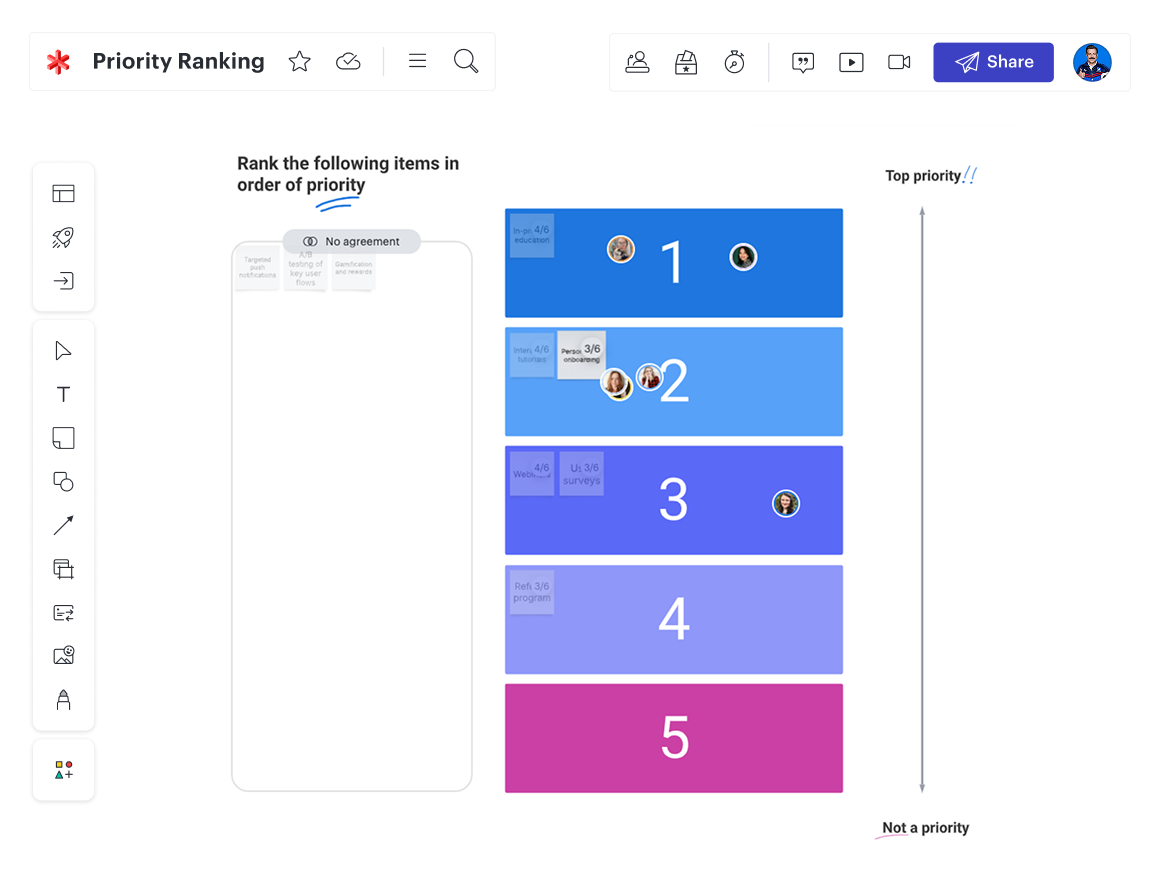
Lesson #2: Be intentional with how you enable and facilitate meetings
That brings me to meetings: the common workplace occurrence we love to hate, but simply can’t avoid.
To be honest, I’ve actually grown to enjoy meetings at Lucid. And that’s because we’ve implemented intentional patterns and created cultural norms around meetings that make them much more productive and engaging.
Let me give a few examples of those patterns. For one, we don't present slides very often in meetings since they don’t allow for collaboration. Instead, we bring meeting content into Lucid so everyone can leave questions and notes and contribute in real time during the live session.
Another tactic has been defining clear channels for participants to contribute to during meetings. For our company's all-hands meetings, for instance, we realized that using a Slack channel for employee engagement versus the Zoom chat would allow for more conversation, questions, and celebrations in threads (not to mention, it’s way easier to share memes). At the beginning of every all-hands meeting, we remind the company to use that dedicated Slack channel. The idea is that we’re helping people understand how they have a voice.
And one of my favorite patterns we’ve implemented on our executive team is starting meetings with what we call “the good, the bad, and the uncertain.” Before we dive into the standard agenda, everyone adds their good (wins and celebrations), bad (roadblocks and challenges), and uncertain (questions and concerns) items to a shared Lucid canvas. It's quick, it’s freeform, and it lets us immediately see what's top of mind across the team. This practice isn't just a check-in; it's an intentional strategy that facilitates transparency and alignment.
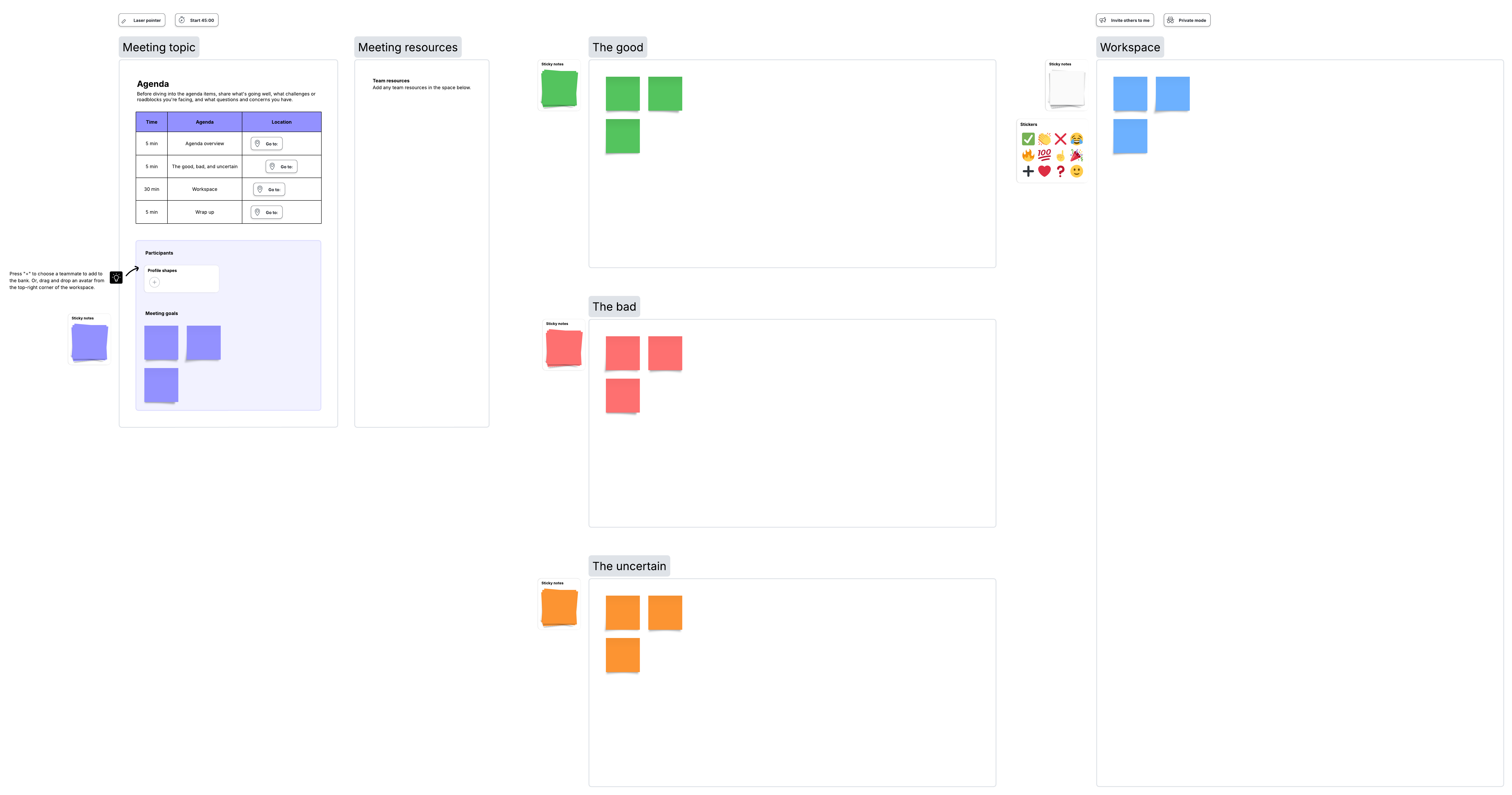
The meeting practices you choose to adopt in your organization may look different, but the point remains: If you want to make meetings more effective, you have to be deliberate.
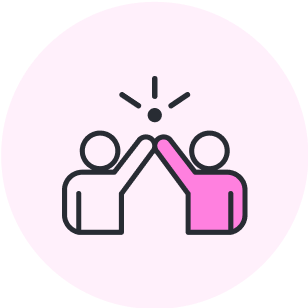
More ways to make meetings effective
Lucid employees share their favorite techniques for facilitating productive and engaging meetings.
Learn moreLesson #3: Have a strategy for collaboration beyond meetings
Of course, looking holistically at collaboration means looking beyond meetings, so we’ve also been really intentional about enabling asynchronous collaboration at Lucid.
The keyword here is intentional. Asynchronous work, in some capacity, would happen regardless of whether or not you’re intentional about it. But if you are intentional, you turn asynchronous collaboration from a mere byproduct of not being in the office together into a key strategy for being more efficient and innovative.
What do I mean by intentional? At Lucid, we’ve defined tools and channels we use for different types of asynchronous collaboration. For example, some types of communication make sense in Slack, such as quick status updates and questions, and others make more sense in Lucid, where we can have visual context, such as sharing project timelines or brainstorming improvements to a process.
With teams spread across the U.S., Europe, and Australia, these asynchronous collaboration patterns have allowed us to collaborate seamlessly across time zones. Because teams know what channels to use and when, there’s a sense of consistency around where information is stored and how work gets done.
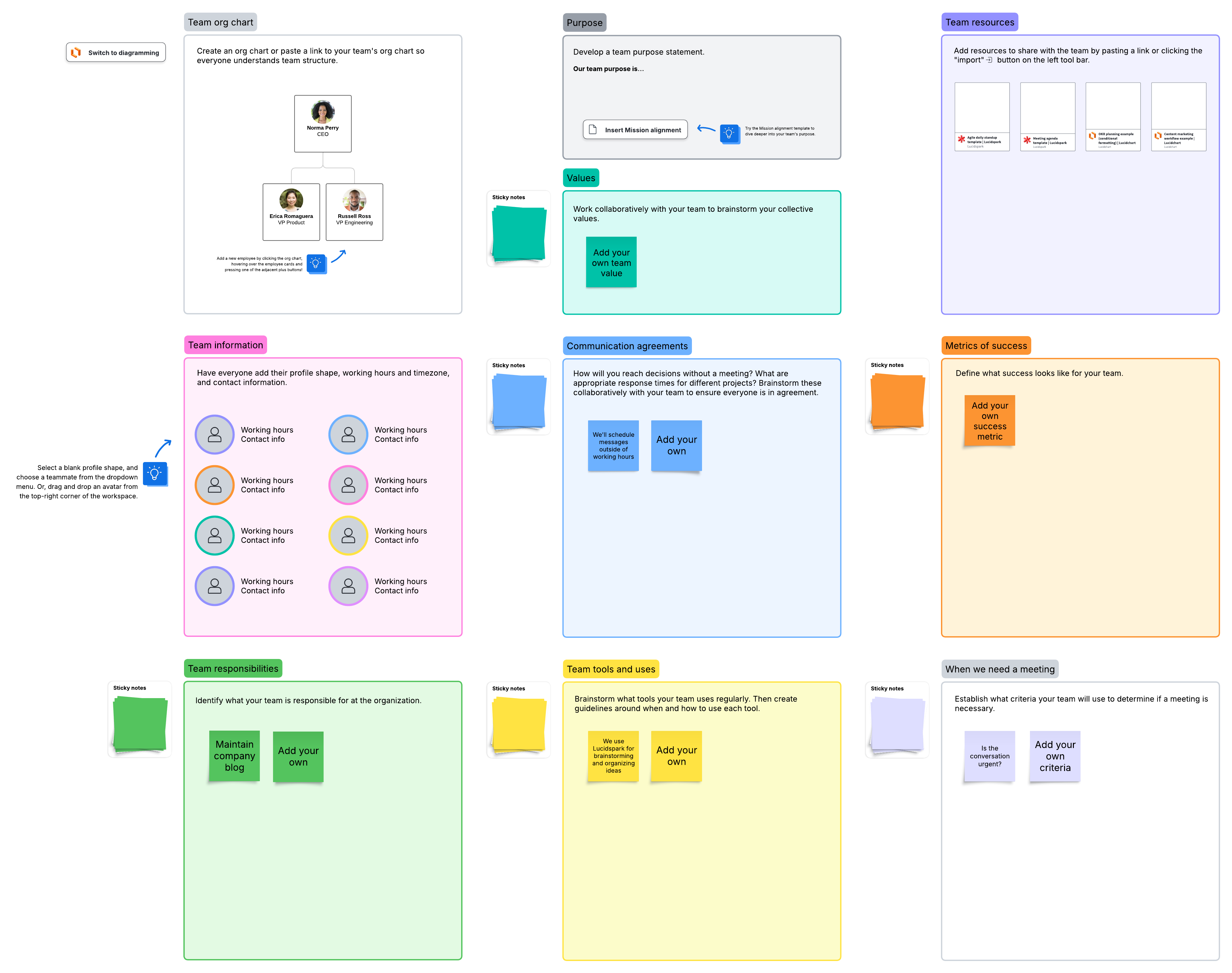
Lesson #4: Establish transparent decision-making processes
Every organization, whether its workforce knows it or not, has collaborative patterns for activities like making decisions, but not every organization has been intentional about defining these patterns. Unfortunately, the patterns that form unintentionally can sometimes create obstacles for teams and slow down progress.
Let me give you an example. One of the common default workplace patterns we see is top-down decision-making–that is, people take questions to their boss, who takes them to their boss, and eventually, a decision is made at the top and passed back down the chain. It’s easy to see how this pattern can stifle innovation and delay outcomes.
Our goal is instead to empower teams to engage directly with the executives they need input from. To do this, we’ve made the processes and forums for strategic decision-making clear and transparent.
Here’s what this pattern looks like for product strategy decisions:
-
Cadence: We’ve set up a consistent weekly cadence for live discussions, intentionally considering the group of people who need to participate in these meetings. Teams feel confident knowing there is dedicated time set aside to get input from executives.
-
Frameworks: We’ve established an easy-to-access framework for contributing to the live meeting so people don’t spend time prepping the way the content looks for the meeting, but instead focus on the key discussion points we need to hit. Using the same Lucidspark board for each meeting has created a clear and familiar way for teams to report progress and record next steps.
-
Channels: We’ve set up Slack channels that we use outside of the meeting for asynchronous feedback, so teams have another clear way to engage with key stakeholders.
If we didn't strategically carve out the cadence and framework, we would have a lot of decisions being made in different ways and not always with the right people in the room. Intentionally creating this space has allowed us to make more strategic decisions more consistently. Plus, it’s incredibly valuable to have a record of the data that drove decisions. We can easily reference previous reports and discussions because all the program data is in one central location.
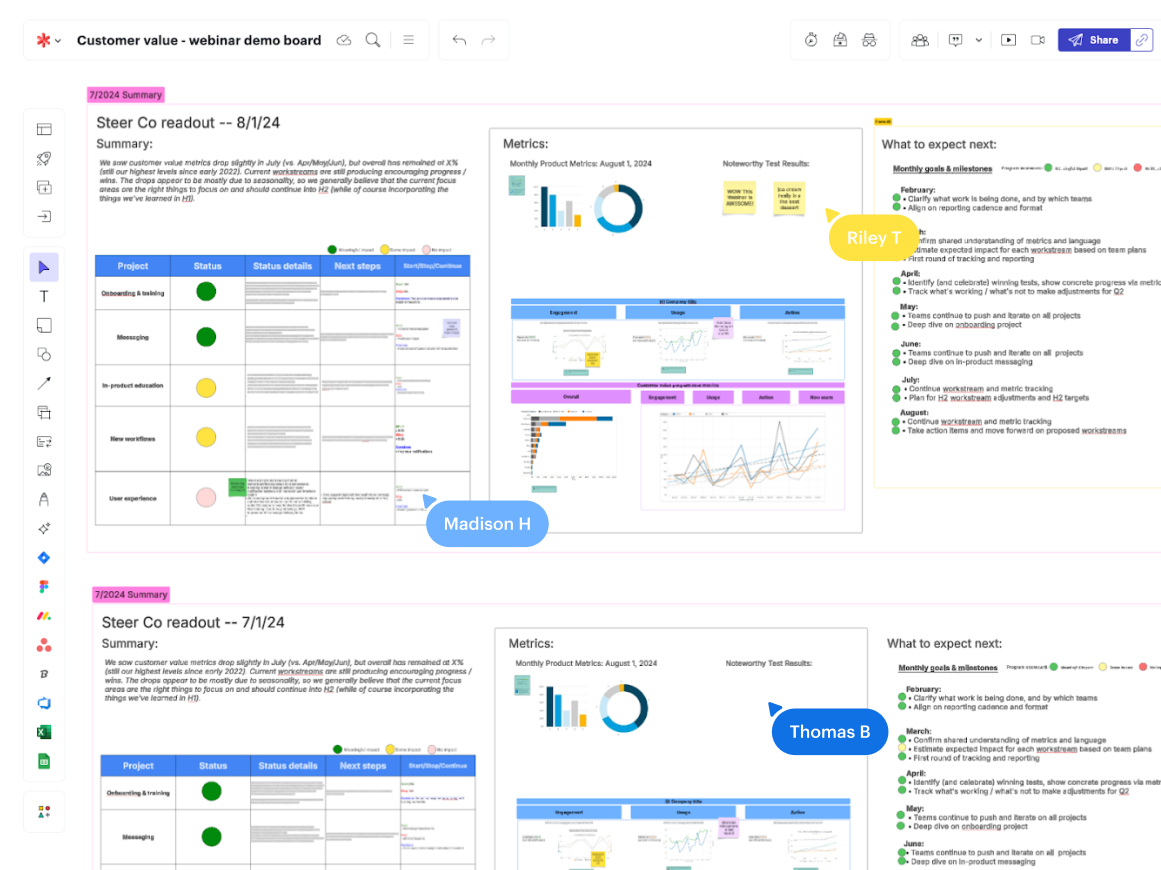
Lesson #5: Align any new technology purchases with your strategy
One of our greatest lessons in enterprise collaboration comes from one of our greatest failures. At some point, we made a decision to switch out one of the key tools in our tech stack. Our goal was to adopt a new tool that would give us more data, cut costs, and be used across the entire company. It was great in theory, but after transitioning tools, we quickly ran into a problem: Very few teams were actually using the tool.
The reason it failed? We made the purchasing decision without a clear understanding of how the new tool would fit into our collaboration strategy. In other words, we didn’t create a clear path for how people were supposed to use it within the broader organization. Sure, there were pockets where teams figured out how to use it. But any time a project involved more than one team, the tool was just too difficult to use, and teams were forced to find workarounds. We didn’t take the time to consider how the tool aligned with our processes and our rituals, so the tool sat unused.
The moral of this story is that before committing to new software, you have to figure out how it fits on both the micro team level and the macro, cross-functional collaboration level. I’d suggest mapping any new tool to your existing or ideal processes and really defining how you want people to leverage it across functions.
Mapping technology to a larger strategy may seem like more work upfront, but it’s worth it to ensure you get broad adoption and value out of a new solution.

How to build a collaboration tech stack
Get tips on choosing the best collaboration technology for your business.
Read the guideLesson #6: Continually test and refine your strategy
Improving enterprise collaboration is a gradual, trial-and-error process that happens over the course of many years.
We’ve learned that when we have a new idea for improving collaboration, engagement, or productivity, it’s best to test the idea before rolling it out as a new policy or tool (see my story above for more on that lesson). You can think of these validation tests as pilot programs.
Here’s an example: The R&D teams at Lucid are experimenting with “no-meetings” blocks of time on certain days. We’re starting with the hypothesis that blocking off time will increase productivity by freeing up that time for more informal or ad hoc collaboration. To determine whether the pilot is successful, we’ll gather team feedback around productivity and look at metrics around time spent in meetings. If it’s a success, we’ll then look at ways to replicate and scale the concept across more teams.
How do we identify opportunities for improvement and experimentation in the first place? One of our favorite ways is through retrospectives. We’ve made retrospectives a critical part of our culture and strategy because they give us a regular chance to revisit our processes, systems, and policies to evaluate whether they’re still serving our goals. They help us capture unfiltered feedback and surface key insights quickly so we can adjust our strategy and continuously improve.
Incorporate these lessons into your enterprise collaboration strategy
As you may have noticed, nearly every one of the lessons I shared wasn’t just about improving collaboration but also standardizing collaboration by clarifying the patterns, processes, and tools teams use.
The next step is to combine this information into an enterprise collaboration strategy—that is, a plan for how people communicate, share knowledge, and make decisions across the organization. I believe that the organizations that approach collaboration strategically will find that it’s the fuel that pushes them toward their strategic goals faster.
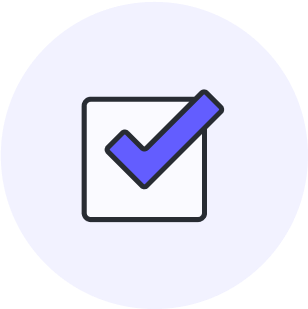
Guide to building an enterprise collaboration strategy
Get expert guidance (+ templates) for building a comprehensive enterprise strategy that accelerates your business goals.
Get the guideAbout the author

Jamie joined Lucid in 2018, driving strategic company initiatives with her impressive talent and leadership skills. After a prestigious consulting role, Jamie earned an MBA from Stanford Graduate School of Business where she was appointed an Arbuckle Leadership Fellow. She later joined General Mills as the Wheaties brand manager, securing a contract with Steph Curry before overseeing marketing, strategy, and business development at a consumer packaged goods startup. She holds a B.A. in economics and Spanish from Dartmouth College.
About Lucid
Lucid Software is a pioneer and leader in visual collaboration dedicated to helping teams build the future. With its products—Lucidchart, Lucidspark, and Lucidscale—teams are supported from ideation to execution and are empowered to align around a shared vision, clarify complexity, and collaborate visually, no matter where they are. Lucid is proud to serve top businesses around the world, including customers such as Google, GE, and NBC Universal, and 99% of the Fortune 500. Lucid partners with industry leaders, including Google, Atlassian, and Microsoft. Since its founding, Lucid has received numerous awards for its products, business, and workplace culture. For more information, visit lucid.co.
Related articles
The problems with workplace collaboration today—and how to fix them
Uncover the top collaboration problems that organizations can't ignore any longer in this blog by Nathan Rawlins, Lucid CMO.
How Lucid’s operations team uses Lucid to maximize efficiency
Lucid’s operations teams use Lucid in their daily workflows to optimize our organization. Here’s how they do it.
Digital collaboration reimagined: A new approach for aligning teams
Whether your teams are in-office, remote, or hybrid, learn why digital-first collaboration is the key to alignment.
Top 6 signs your collaboration needs an overhaul
Learn signs that your collaboration may not be as effective as it could be, plus explore resources to get the best results possible.
